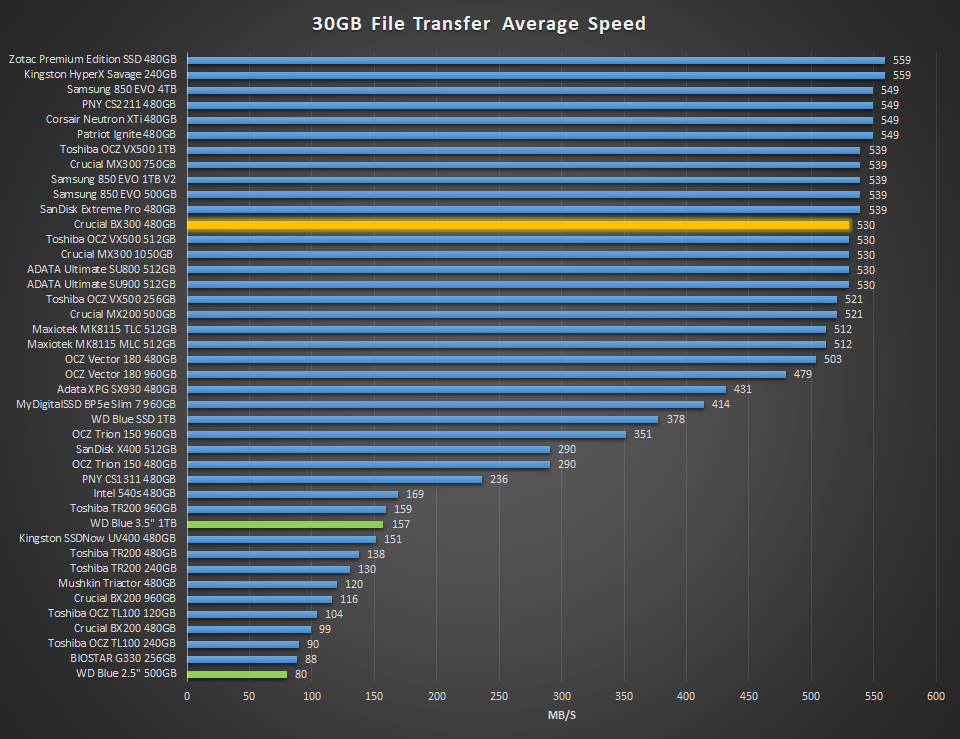REAL WORLD FILE TRANSFER
We also wanted to see how performance was in a real-world use when transferring large files to the SSD. For this test, we are going to simply stress write performance by transferring over a 30GB folder of movies off of a 512GB Samsung 950 Pro to the test SSDs and time how long it takes. Once complete we can calculate the average speed.
The 480GB Crucial BX300 transferred the 30GB test folder in just under a minute, averaging 530MB/s.
HDTUNE
HD Tune is a Hard Disk Utility with many functions from error checking, health testing (S.M.A.R.T.), and of course benchmarking. To build upon our real world write test we also looked to see where the write speeds leveled off to by using HD Tune Pro. If SLC caching is being utilized, this test will typically show it.
With HDTune, we can see that the BX300’s result shows that there is essentially no drop off in performance as you write to the capacity of the SSD.
REPORT ANALYSIS AND FINAL THOUGHTS
In terms of performance, we are more than impressed by this product. The Crucial BX300 is an entry-level SATA SSD based on price and capacity availability, but not in terms of value and performance. Throughout testing the BX300 easily delivered its rated performance specs of 555MB/s read and 510MB/s write and delivering 95K/90K IOPS read/write was just warming this bad boy up. Unlike many other entry-level SSDs, the BX300’s write performance doesn’t drop off thanks to Microns new 3D MLC NAND, at least in our 480GB model. This is what helps to separate this SSD from the rest. In PCMark 8 it delivered a high average bandwidth of 271MB/s and during the extended test it came out as one of the best SATA SSDs we have tested to date! Its consistent low latency and high bandwidth during one of the hardest SSD tests we have ever used demonstrated just how great Micron’s latest 3D MLC NAND can perform under some of the heaviest of workloads. And in addition to this, our real-world 30GB transfer and HDTune’s bombardment of writes barely made the BX300 flinch.
Furthermore, Crucial’s momentum cache helped to improve the BX300’s already stellar performance even more. The benchmark results speak for themselves. The most important one to note was PCMark 8’s result. The BX300’s average bandwidth of 271MB/s jumped all the way up to 350MB/s! This is clear ahead of any other SATA SSD on the market. So, it is definitely worth checking out.
FINAL THOUGHTS
We can say without a doubt that the Crucial BX300 is one of the top value SSDs on the market where SATA SSDs are a commodity. Everyone is manufacturing and selling them and thus, it has become a race to the bottom for quite some time.
- How fast is fast enough?
- Does the SSD need any accessories?
- Can we use cheaper NAND and enhance performance through firmware for cheaper than the price to use higher quality NAND or MLC?
These are some of the questions these companies are asking and testing. Crucial delivered the BX200 with a compromise on performance with their use of TLC. After this, many were upset it and now, this time around, they’ve made up for it. Thanks to their use of Micron’s 3D MLC NAND, this low-cost SSD can keep up with the best. It even has a lot of accessories too.
- SSD Toolbox? Check.
- 7.5mm to 9mm spacer? Check.
- Cloning software? Check.
There really isn’t a lot to be expected from a lower cost SSD, but here’s Crucial delivering on their promise of value. They want to obliterate the competition in SSD sales and claw their way to the top by delivering the mass majority of the market the SSD package they just can’t resist.
The BX Series’ come back with 3D MLC leaves it in a weird place in my mind, however. In June of 2016 they released the MX300, it is the higher-end SSD to the BX Series SSDs. To our surprise, it used 3D TLC, rather than MLC, contrary to what you would expect out of a higher-end SSD. Its performance was acceptable for what it was, but still, slower TLC in their top of the line SSD? And here the cheaper product line features higher performance 3D MLC? It just doesn’t seem right. It’s like putting the big V12 Bi-Turbo from the BMW 760Li into a 1, 2, or 3 Series or vice versa and selling them at their same base prices. We will just have to wait to see what the next MX Series update will have in it. It’s been nearly a year and a half since we saw an update, hasn’t it?
With some of the lowest prices per GB, an impressive accessory package, and performance that rivals some of the best SATA SSDs on the market, the Crucial BX300 a great buy. We would more than gladly recommend it to you if you are in search of your next SATA SSD and we award it our Editor’s Choice award.
Pros
- Both light & heavy workload performance
- Great accessory package
- Low prices
Cons
- Low endurance despite having 3D MLC
- Limited/lower capacity options
 The SSD Review The Worlds Dedicated SSD Education and Review Resource |
The SSD Review The Worlds Dedicated SSD Education and Review Resource | 


GREAT-With this and Toshiba 3d out there perhaps the race to the bottom is over.
If this is priced right perhaps we can say RIP planer TLC and ram-less drives.
it may be time to buy ssds again. if they start using mlc again.
This means I can ignore Intel’s Optane for a little while longer.
Curious as to what indicates this SSD uses SLC caching mode when it sports the DRAM that the SMI 2258HX normally uses as the caching element…